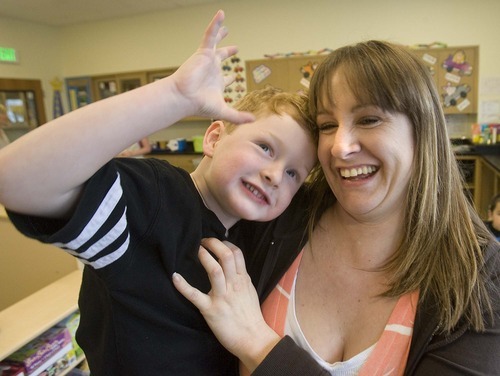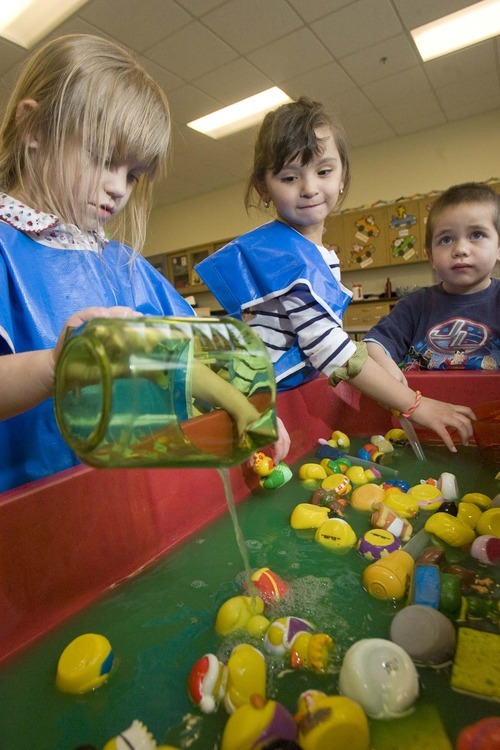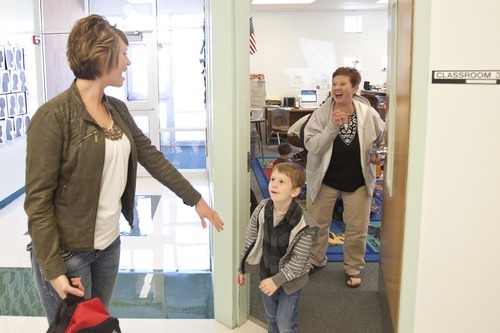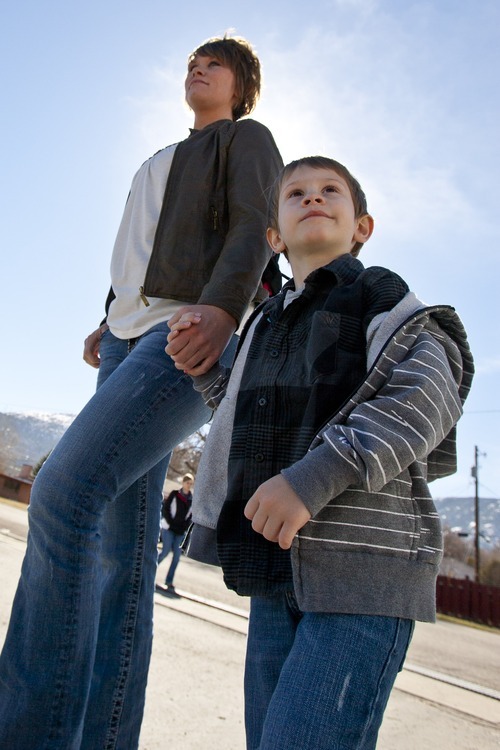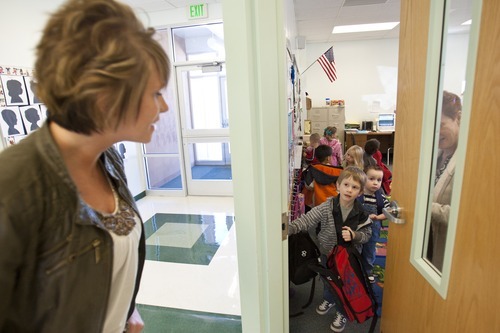This is an archived article that was published on sltrib.com in 2011, and information in the article may be outdated. It is provided only for personal research purposes and may not be reprinted.
When Brandee Reese became pregnant soon after high school, friends and family had plenty to say about whether or not to keep the baby.
"It was really hard. I thought about every possibility," says the now-23-year-old mother of a bright, energetic 4-year-old boy, Karson. "I just took everyone out of the picture and asked myself what I wanted."
Reese applies that same "do what it takes" attitude to earning a teaching degree at Southern Utah University (SUU), a financial burden she manages by working two jobs and with government support — including subsidized child care and tuition, and health coverage through the low-income Medicaid program.
Could she do it without that help? Studies suggest few do, driving debate about making college more affordable. But the bipartisan consensus among Utah lawmakers is that students like Reese should go it alone when it comes to health care.
Tasked with controlling Medicaid spending, legislators have bemoaned rumored scores of college students rolling up to hospital maternity wards in luxury cars and having babies on the state's dime. Family advocates downplay the anecdotes as apocryphal.
But state data confirm that Medicaid is, indeed, a key source of health care financing for student parents in rural and urban Utah.
In 2008, Medicaid paid for a quarter of the state's births. But it paid for 44 percent of births to parents who listed "student" as their occupation on birth certificate forms.
In Cache County, home to Utah State University, Medicaid picked up the tab for 53 percent of student births, and in SUU's backyard of Iron County, 69 percent, state records show.
Younger student parents, under 26 years of age, are even more likely to turn to Medicaid.
Still, the total number of subsidized student deliveries is small: 1,276 in 2008, about 11 percent of all Medicaid births statewide.
The lion's share of those births, 499, happened in Utah County, home to Utah Valley University and LDS Church-owned Brigham Young University.
"These are 90 percent out-of-state students having babies on our dime," said Sen. Howard Stephenson, R-Draper, referring to the LDS Church youth drawn to those schools from around the country.
—
Insurance mandate • Data to inform the debate are scarce and getting scarcer.
Medicaid doesn't closely track beneficiaries' student status, only their income — of which college students tend to have little — and assets, excluding a car. And 2008 is the last snapshot available from Utah's Office of Vital Records and Statistics, which records whether a mother is on Medicaid but no longer asks parents their occupation.
Vital records aren't a perfect measure. Since not all students declare themselves as such, it may be an undercount, said Barry Nangle, data director at the Utah Department of Health.
Reasoning that if college students have resources to chase a degree — namely, affluent parents — they should pay for their own medical care, Republicans and Democrats this winter talked about requiring them to buy health policies with maternity coverage.
Such a plan would have saved $1 million annually in state funds, plus matching federal funds, but no legislation surfaced.
Nothing forbids colleges from imposing their own mandate. BYU does, but the campus plan carries a $5,000 deductible, about equal to the cost of an uncomplicated delivery, according to health department data.
The University of Utah tried a mandate in 1994 but dropped the requirement after one semester, under push back from students. In 2006, only 20 percent of the university's students had coverage, said Kerry Hill, a coordinator in the Student Support Center.
That's supposed to change under federal health care reform. Now, single and married students up 26 years of age can stay on their parents' insurance plans. Still, not everyone's parents are insured, and some might balk at footing the health care bills of their adult children.
Come 2014, the federal law will require nearly all Americans to have health coverage.
"The only way to make insurance affordable is to mandate that everyone buy it," said Lincoln Nehring, senior health policy analyst at Voices for Utah Children. "Whatever you say about Obamacare, it makes a serious attempt at tackling these problems, of capturing the efficiencies of insuring everyone as a critical first step toward making health care more affordable."
Records show the student birth rate remained fairly constant from 2006 through 2008, but student births likely slowed during the recession along with the state's birth rate.
Over the past two years total births at Valley View Medical Center in Iron County hovered at about 900, down from about 1,000 in 2009 and 2007, said the facility's CEO Jason Wilson.
About half the deliveries last year at Valley View were paid by Medicaid, "some of them to college students," said Wilson. "You've got mothers delivering babies. You want to provide them a safe, comfortable place and it's nice to know there's that safety net. Are we doing it the best way through Medicaid? I don't know."
—
Collision course • The dilemma of funding Medicaid is sure to occupy growing states like Utah for years to come.
Higher education and health care are on a collision course, believes Utah Valley University President Matthew S. Holland. The two industries are lone standouts for relentless double-digit inflation, outpricing many middle-class families — indicated by rising student dropout rates and the ranks of uninsured.
From where Holland sits, the problem is the nation's growing entitlement culture. While shrinking investments in education, the best public program for creating productive, engaged citizens, the state has exploded investments in Medicaid, he said.
For students, though, the calculation isn't as simple as choosing to invest in one over the other.
Once considered a privilege, postsecondary education is now generally seen as the singular path to jobs with decent wages and health benefits. But unexpected medical costs and other financial drains are chief reasons for so many students dropping out, according to the Bill and Melinda Gates Foundation.
Up to 23 percent of college students have dependent children, and 45 percent to 60 percent work more than 20 hours a week, the foundation reports.
"Penalizing someone for having a baby while they're still a poor college student seems short-sighted, considering Utah's religious culture and emphasis on marriage and big families," said Lynne Brown, director of SUU's Student Support Center. "In my 25 years here, I've known plenty who have gone on to build lucrative careers and pay it all back in taxes. I worry more about people who aren't getting an education and who will be on Medicaid for years."
—
Support at school • Recognizing the competing demands on today's students, Utah's public colleges have ramped up student supports. Utah Valley and Salt Lake Community College recently opened steeply discounted on-campus child care centers staffed by early childhood learning experts.
"Demand was huge," said Shalome Orton, who heads up the day care at Salt Lake Community College's campus in South Salt Lake. The center opened in January and already has a waiting list 72 parents long, she said.
"It's clean, safe and affordable," said 30-year-old single mother Amanda Goss. Her 4-year-old son Ian attends the program five days a week for $10 a day while she works toward a degree in social work.
The camaraderie with other moms is helpful and Goss likes that she can steal Ian away for lunch or a break on the playground in between classes. "I wouldn't be here if it weren't for this place," said Goss who lives with her mother and is on Medicaid.
SUU stockpiles diapers and sponsors parenting classes and support groups. Through a federal grant, the school also pays child care costs for returning students, single or married.
Funding for most services is limited and doled out on a sliding scale based on income. Reese qualifies for $125 a month, about a quarter of her child care costs. Federal aid covers most of her tuition.
"I'm lucky," she says, referring also to help from her parents, both postal workers who live nearby. Reese remains on their health plan.
Her doctor told her to also temporarily enroll in Medicaid, which picked up any leftover expenses from her pregnancy. And her son is now on the affiliated Children's Health Insurance Program (CHIP).
Part-time work at a hotel and a juvenile detention center covers her mortgage and other expenses. She says she would finish her degree with or without public aid, though it would mean falling deeper in debt.
As it is, over four years she'll save up to $28,416 in tuition, $20,000 in health insurance premiums and $1,500 in child care.
"It's just something I'm committed to do to better my life and my son's life," Reese says.
Qualifying for Medicaid
Anyone who enrolls in Medicaid must meet income and asset limits; a single pregnant woman can earn no more than $10,890 a year and have no more than $2,000 in assets, excluding a car. Medicaid is a joint federal-state program with Utah kicking in less than a quarter of the costs. Even so, the state budgetary burden is significant, resting now at nearly $400 million and expected to balloon to $800 million by 2020.


